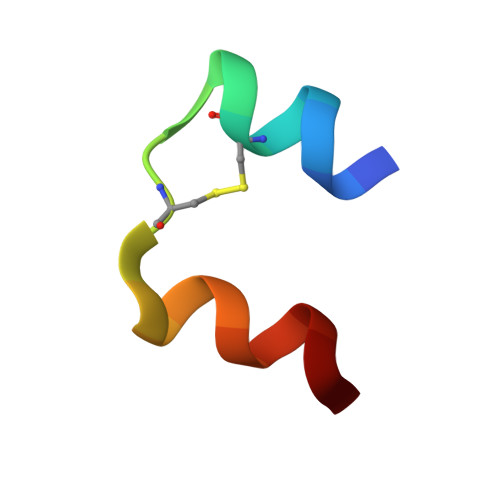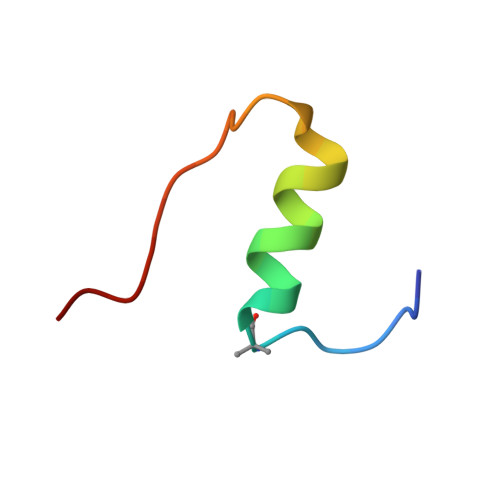Insight into the structural and biological relevance of the T/R transition of the N-terminus of the B-chain in human insulin.
Kosinova, L., Veverka, V., Novotna, P., Collinsova, M., Urbanova, M., Moody, N.R., Turkenburg, J.P., Jiracek, J., Brzozowski, A.M., Zakova, L.(2014) Biochemistry 53: 3392-3402
- PubMed: 24819248
- DOI: https://doi.org/10.1021/bi500073z
- Primary Citation of Related Structures:
2MPG, 4CXL, 4CXN, 4CY7 - PubMed Abstract:
The N-terminus of the B-chain of insulin may adopt two alternative conformations designated as the T- and R-states. Despite the recent structural insight into insulin-insulin receptor (IR) complexes, the physiological relevance of the T/R transition is still unclear. Hence, this study focused on the rational design, synthesis, and characterization of human insulin analogues structurally locked in expected R- or T-states. Sites B3, B5, and B8, capable of affecting the conformation of the N-terminus of the B-chain, were subjects of rational substitutions with amino acids with specific allowed and disallowed dihedral φ and ψ main-chain angles. α-Aminoisobutyric acid was systematically incorporated into positions B3, B5, and B8 for stabilization of the R-state, and N-methylalanine and d-proline amino acids were introduced at position B8 for stabilization of the T-state. IR affinities of the analogues were compared and correlated with their T/R transition ability and analyzed against their crystal and nuclear magnetic resonance structures. Our data revealed that (i) the T-like state is indeed important for the folding efficiency of (pro)insulin, (ii) the R-state is most probably incompatible with an active form of insulin, (iii) the R-state cannot be induced or stabilized by a single substitution at a specific site, and (iv) the B1-B8 segment is capable of folding into a variety of low-affinity T-like states. Therefore, we conclude that the active conformation of the N-terminus of the B-chain must be different from the "classical" T-state and that a substantial flexibility of the B1-B8 segment, where GlyB8 plays a key role, is a crucial prerequisite for an efficient insulin-IR interaction.
- Institute of Organic Chemistry and Biochemistry, Academy of Sciences of the Czech Republic , v.v.i., Flemingovo nám 2, 166 10 Prague 6, Czech Republic.
Organizational Affiliation:


















